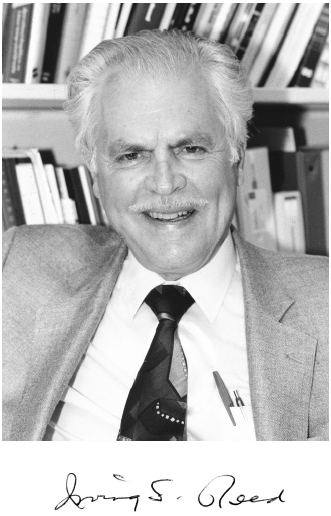
1923–2012
Elected in 1979
“For contributions to automatic detection and processing of radar data, multiple-error-correcting communications codes and digital computer design.”
BY SOLOMON W. GOLOMB
IRVING STOY REED was born on November 12, 1923, in Seattle, Washington, and grew up in Fairbanks, Alaska, where he started college at the University of Alaska. He transferred to the California Institute of Technology (Caltech), where he earned his bachelor’s degree (1944) and PhD (1949), both in mathematics with a minor in physics. Between degrees he served in the US Navy (1945–1946) as a radar technician on a ship in the Pacific. Afterward, while a graduate student at Caltech, he was involved in the development of one of the very first digital computers, the Northrop MADDIDA (Magnetic Drum Digital Differential Analyzer), used in aviation guidance systems.
From 1951 to 1960 he worked at MIT’s Lincoln Laboratory, where he developed computer programming languages, the theory and analysis of radar systems—with applications to missile defense—and the Reed-Muller and Reed-Solomon codes for protecting the integrity of digital information. From there he went to the Rand Corporation in Santa Monica, California, where he continued to work on coded communications and radar systems. In 1963 he joined the faculty of the University of Southern California (USC), where he became the first holder of the Charles Lee Powell Chair in Electrical Engineering and Computer Science, which he held until his retirement in 1993, with the title of Powell Chair of Engineering Emeritus.
With a joint appointment in the Departments of Electrical Engineering and Computer Science, Reed was a founding member of both the Communication Sciences Institute and the Signal and Image Processing research groups. With a succession of talented graduate students, he worked to improve decoding algorithms for error-correcting codes and the data compression methods that became the basis for the jpeg image standard that is now ubiquitous for image storage and transmission.
Reed had a wide range of knowledge and interests that spanned physics, electromagnetics, and aviation. As a mathematician, he realized that finite field theory had practical applications in what became known as algebraic error-correcting codes to preserve the integrity of both stored and transmitted digital information. (While others had only observed that the easiest algebraic codes had the structure of a commutative group, Reed observed that the codes he codeveloped with David E. Muller had the additional structure of a linear vector space, and that his subsequent Reed-Solomon codes had the further structure of linear algebra.) The codes he pioneered are now found almost everywhere—in CDs, DVDs, disk drives, PDAs, cell phones, iPhones, space communications, wired and wireless communications, and the computer networks that make up the Internet. It is fair to say that none of these would work without error-correcting codes.
His many honors and awards include the following. He was elected a fellow of the Institute of Electrical and Electronics Engineers (IEEE; 1973) and a member of the NAE (1979). He received the Claude E. Shannon Award (1982) of the IEEE Information Theory Society (including delivery of the Shannon Lecture at the Society’s 1982 meeting in Les Arcs, France); the IEEE Richard W. Hamming Medal (1989) “For contributions to multiple error-correcting codes, digital computer design, and automatic detection and processing of signals in noise”; the Charles Babbage Award of the Orange County Chapter of the IEEE Computer Society (1989) “for outstanding contributions to the evolution of computer technology and coding theory”; the Masaru Ibuka Consumer Electronics Award (1995), jointly
with Gustave Solomon, for invention of the Reed-Solomon codes; and the IEEE Warren D. White Award for Excellence in Radar Engineering (2001). He was awarded honorary doctor of science degrees in 1998 from the Universities of Alaska and Colorado, and Caltech’s Distinguished Alumnus Award (1992). He also received numerous research awards from USC, JPL, and NASA.
Reed was a listed inventor on a dozen US patents, author or coauthor of 12 books or book chapters, and author or coauthor of more than 200 papers in technical journals, spanning the 60-year period of 1944–2004.
Irving Reed died on September 11, 2012, two months shy of his 89th birthday, in Santa Monica, where he had lived since 1960. The technology he developed has brought important and lasting benefits to society, and he will long be remembered as one of the exceptional innovators of the twentieth century.
He is survived by his wife Bernice, two sons, ten grandchildren, and four great-grandchildren.




